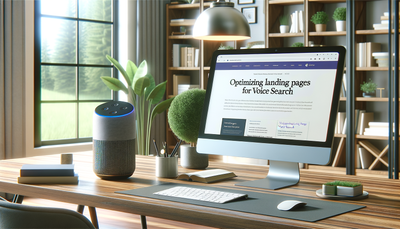Optimizing Landing Pages for Voice Assistants and Smart Displays
As voice assistants and smart displays become increasingly prevalent in our daily lives, it's crucial for businesses to optimize their landing pages for these emerging technologies. This article explores the strategies and techniques necessary to adapt your landing pages for voice search and smart screens. We'll delve into the importance of structured data, creating voice-friendly content, and optimizing visuals for smart displays. By implementing these approaches, you can ensure your landing pages are discoverable, accessible, and engaging across various devices and platforms, ultimately improving your online presence and user experience.Table of Contents:
-
Understanding the Rise of Voice Assistants and Smart Displays
- Implementing Structured Data for Enhanced Discoverability
- Creating Voice-Friendly Content
- Optimizing Page Speed and Mobile Responsiveness
- Enhancing Visual Elements for Smart Displays
- Leveraging Local SEO for Voice Search
- Incorporating Action-Oriented Content
- Implementing Structured Data for Enhanced Discoverability
- Creating Voice-Friendly Content
- Optimizing Page Speed and Mobile Responsiveness
- Enhancing Visual Elements for Smart Displays
- Leveraging Local SEO for Voice Search
- Incorporating Action-Oriented Content

Understanding the Rise of Voice Assistants and Smart Displays
Voice assistants and smart displays have experienced exponential growth in recent years, with devices like Amazon Echo, Google Home, and Apple HomePod becoming commonplace in homes and offices. These technologies are changing the way users interact with the internet, search for information, and make purchasing decisions.Smart displays, which combine voice assistants with visual interfaces, offer even more opportunities for businesses to engage with their audience. As these technologies continue to evolve, it's essential for website owners to adapt their landing pages to cater to this growing market and ensure their content is easily accessible through voice commands and visual displays.
Do you need a website? Want to build a website but don't know where to start? Our website builder is the perfect solution. Easy to use, and with the ability to customize to fit your business needs, you can have a professional website in no time.
Implementing Structured Data for Enhanced Discoverability
One of the most crucial steps in optimizing landing pages for voice assistants and smart displays is implementing structured data. Structured data, also known as schema markup, helps search engines understand the content and context of your web pages more effectively.By adding structured data to your landing pages, you can provide clear information about your business, products, or services, making it easier for voice assistants to find and present relevant information to users. Focus on implementing schema markup for key elements such as your business name, address, phone number, operating hours, and product details. This will increase the likelihood of your content being featured in voice search results and on smart displays.
Creating Voice-Friendly Content
When optimizing your landing pages for voice search, it's important to consider how people naturally speak and phrase their questions. Unlike traditional text-based searches, voice queries tend to be longer and more conversational in nature.To cater to this trend, focus on creating content that answers common questions related to your business or industry. Incorporate long-tail keywords and natural language phrases into your landing page copy. Consider adding an FAQ section that directly addresses potential voice queries. By anticipating and answering user questions, you increase the chances of your content being selected as a voice search result.
Building a website with SITE123 is easy
Optimizing Page Speed and Mobile Responsiveness
Page speed and mobile responsiveness are critical factors in optimizing landing pages for voice assistants and smart displays. Voice searches are often performed on mobile devices, and smart displays require quick-loading, responsive content.Ensure your landing pages load quickly by optimizing images, minifying code, and leveraging browser caching. Use responsive design techniques to create a seamless experience across various screen sizes and devices. By prioritizing speed and responsiveness, you improve the user experience and increase the likelihood of your content being served by voice assistants and smart displays.
Enhancing Visual Elements for Smart Displays
While voice search optimization is crucial, it's equally important to consider the visual aspects of your landing pages for smart displays. These devices combine voice interactions with visual interfaces, offering opportunities to engage users through compelling imagery and design.Optimize your landing page visuals by using high-quality, relevant images that complement your content. Consider creating infographics or short video clips that summarize key information, making it easy for users to grasp important details at a glance. Ensure that your visual elements are properly tagged with descriptive alt text, allowing voice assistants to accurately describe images to users when necessary.
Leveraging Local SEO for Voice Search
Many voice searches have local intent, with users often seeking nearby businesses or services. To capitalize on this trend, it's essential to optimize your landing pages for local SEO.Ensure your business information is consistent across all online platforms, including your website, social media profiles, and business directories. Include location-specific keywords in your content and meta tags. Consider creating dedicated landing pages for each location if you have multiple business locations. By focusing on local SEO, you increase the chances of your business being recommended by voice assistants when users make location-based queries.
Incorporating Action-Oriented Content
Voice assistants and smart displays are often used for task completion, such as making reservations, placing orders, or getting directions. To cater to this behavior, incorporate action-oriented content into your landing pages.Include clear calls-to-action (CTAs) that are easy to understand and execute through voice commands or touch interactions on smart displays. For example, use phrases like 'Book Now,' 'Get Directions,' or 'Call Us' prominently on your landing pages. Ensure that these actions can be easily completed through voice commands or simple touch interactions on smart displays, providing a seamless user experience.





